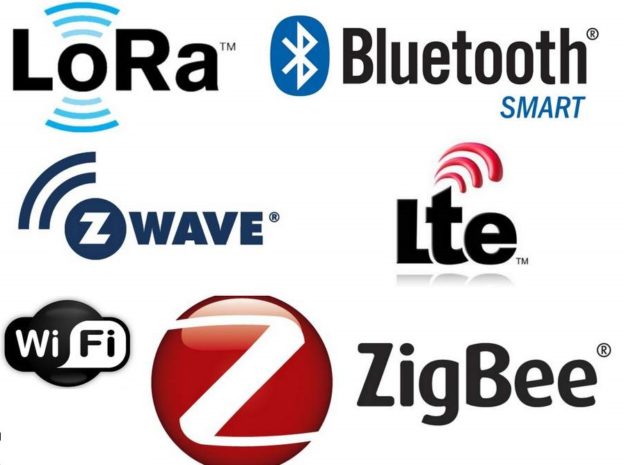
The wireless technology and networks allow devices to speak (send data) to each other and to the web (TCP/IP Networks) without cables. There are a number of different wireless technologies out there that can be implemented in hardware products for the Internet of Things (IoT) and Machine to Machine (M2M) communication.
Various types of wireless technologies for IoT
Wi-Fi uses radio waves (RF) to allow two devices to communicate with one another. The technology is most commonly used to connect Internet routers to devices like computers, tablets and phones. Wi-Fi is a local wireless network.
But, Wi-Fi is not often a feasible solution for connecting IoT end devices because of its major limitations in coverage, scalability and power consumption. Instead, the technology can perform as a back-end network for offloading aggregated data from a central IoT hub to the cloud.
Wi-Fi HaLow is also the first Wi-Fi specification to operate in frequency bands below one gigahertz (900 MHz), and it has a range of nearly twice that of other Wi-Fi technologies. In addition to its extended range capabilities, Wi-Fi HaLow is also able to penetrate walls and other barriers considerably better than previous Wi-Fi standards.
Power-efficient use cases for Wi-Fi HaLow include devices designed for smart homes and smart cities, connected cars, digital health care markets, and industrial and retail environments.
Bluetooth and Bluetooth Low Energy (BLE) are wireless technologies used to transfer data over short distances. The technology is frequently used in small consider devices that connect to users phones and tablets. For instance, the technology is used in many speaker systems.
Bluetooth Low Energy uses less power than standard Bluetooth and is used in hardware such as fitness trackers, smart watches and other connected devices in order to wirelessly transmit data without heavily compromising with the battery power.
Cellular networks are not viable for the majority of IoT applications powered by battery-operated sensor networks, they fit well in specific use cases such as connected cars or fleet management in transportation and logistics.
For example, in-car infotainment, traffic routing, advanced driver assistance systems (ADAS) alongside fleet telematics and tracking services can all rely on the ubiquitous and high bandwidth cellular connectivity.
Cellular next-gen 5G with high-speed mobility support and ultra-low latency is positioned to be the future of autonomous vehicles and augmented reality. 5G is also expected to enable real-time video surveillance for public safety, real-time mobile delivery of medical data sets for connected health, and several time-sensitive industrial automation applications in the future.
ZigBee is a short-range, low-power. Commonly deployed in mesh topology to extend coverage by relaying sensor data over multiple sensor nodes. Compared to LPWAN, ZigBee provides higher data rates, but at the same time, much less power-efficiency due to mesh configuration.
Because of their physical short-range (< 100m), ZigBee and similar mesh protocols (e.g. Z-Wave, Thread etc.) are best-suited for medium-range IoT applications with an even distribution of nodes in close proximity. Typically, ZigBee is a perfect complement to Wi-Fi for various home automation use cases like smart lighting, HVAC controls, security and energy management.
“Z-wave” may not be a name you hear every day, but is proving to be one of the most popular wireless technologies for IoT products. Z-wave is a special protocol used specifically for home automation and connectivity. Perhaps the most famous example of Z-wave technology right now is Amazon’s Echo. There are over 2000 Z-wave products on the market, allowing connectivity for household products ranging from smart garage door openers, fire alarms, fans and blinds, to remote-controlled front door locks and thermostats.
Radio Frequency Identification (RFID) uses radio waves to transmit small amounts of data from an RFID tag to a reader within a very short distance. Till now, the technology has facilitated a major revolution in retail and logistics.
By attaching an RFID tag to all sorts of products and equipment, businesses can track their inventory and assets in real-time – allowing for better stock and production planning as well as optimized supply chain management. Alongside increasing IoT adoption, RFID continues to be entrenched in the retail sector, enabling new IoT applications like smart shelves, self-checkout, and smart mirrors.
Licensed LPWAN (LTE-M, EC-GSM, NB-IOT)
Unlicensed LPWAN (MIOTY, LoRa, Sigfox)
Low Power Wide Area Networks (LPWANs) are the new phenomenon in IoT. By providing long-range communication on small, inexpensive batteries that last for years, this family of technologies is purpose-built to support large-scale IoT networks sprawling over vast industrial and commercial campuses.
LPWANs can literally connect all types of IoT sensors – facilitating numerous applications from remote monitoring, smart metering and worker safety to building controls and facility management. Nevertheless, LPWANs can only send small blocks of data at a low rate, and therefore are better suited for use cases that don’t require high bandwidth and are not time-sensitive.
Also, not all LPWANs are created equal. Today, there exist technologies operating in both the licensed (NB-IoT, LTE-M) and unlicensed (e.g. MIOTY, LoRa, Sigfox etc.) spectrum with varying degrees of performance in key network factors. For example, while power consumption is a major issue for cellular-based, licensed LPWANs; Quality-of-Service and scalability are main considerations when adopting unlicensed technologies. Standardization is another important factor to think of if you want to ensure reliability, security, and interoperability in the long run.
Positioning of different IoT wireless technologies
Each IoT vertical and application has its own unique set of network requirements. Choosing the best wireless technology for your IoT use case means accurately weighing criteria in terms of range, bandwidth, QoS, security, power consumption, and network management.